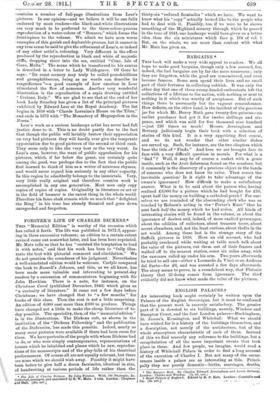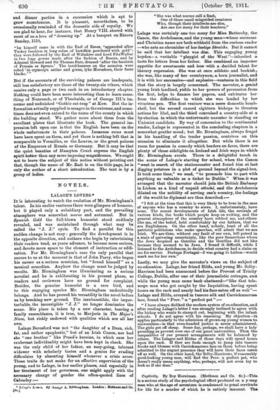ENGLISH PALACES.f
AN interesting book might certainly be written upon the Palaces of the English Sovereigns, but it must be confessed that the present work is scarcely satisfactory. The greater part of it is devoted to six buildings, namely, Windsor and Hampton Court, and the four London. palaces—Buckingham, St. James's, Kensington, and Whitehall. What we should have wished for is a history of the buildings themselves, and a description, not merely of the architecture, but of the whole atmosphere characteristic of each of them. Instead of this we find scarcely any reference to the buildings, but a recapitulation of all the more important events that took place in them. And few people, we imagine, would read a history of Whitehall Palace in order to find a long account of the execution of Charles L But not many of the occur- rences inside a palace are as interesting as this. Princi- pally they are purely domestic—births, marriages, deaths, • The Bargain Book. By Charles Edward Jerningham and Lewis Bettany, London : Cheat) and Windus. [7s. 6d. net.J t Royal Palaces of England. Edited by B. S. Bait. London s Constable and and dinner parties in a succession which is apt to grow monotonous. It is pleasant, nevertheless, to be occasionally reminded of the domestic side of royalty. We are glad:6 hear, for instance, that Henry VIII. shared with most .of us s love of "dressialg up." At a banquet on Shrove
Sunday, 1510,
"he himself came in with the Earl of Essex, .'appareled after Turkey fasshion in long-robes of lavalkin powdered with gold': they were followed by the Earl .of Wiltshire and Lord FitzWalter in two long gowns made after the fashion of Russia, and by Admiral Howard -and Sir Thomas Parr, dressed 4after fasshion of Prussia or Spruce.' The torchbearers on the occasion were robed in crymosyn satin and grene, lyke Moroskoes, their faces blacke.' "
But if the accounts of the surviving palaces are inadequate, still less satisfactory are those of the twenty,six others, which receive: only a page or two each in an introductory -chapter.
Nothing could.have been more interesting than to learn some- thing of Nonesuch, or of Theobalds, or of George III.'s ism. mense and unfinished "-Gothic rat-trap" at Kew. But the in- formation.actually supplied-is meagre in the extreme, and some- times does not even extend to the name of the county in which the building stood. We gather more about them from the excellent plates that illustrate the book. The general im- pression left upon one is that the English have been on the whole unfortunate in their palaces. Immense sums must have been spent on them, and yet there is nothing left that ,is comparable to Versailles, or the Louvre, or the -great palaces of the Emperors of Russia or -Germany. But it may be that the quiet beauties -of Hampton _Court .express the English spirit better Ilan any more imposing magnificence. We ought not to leave -the subject of this notice without pointing eut that, -though the name of Mr. Rait is on the title page, be is only the author of a short introduction. The text is by a group of ladies.











































 Previous page
Previous page